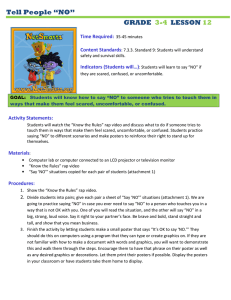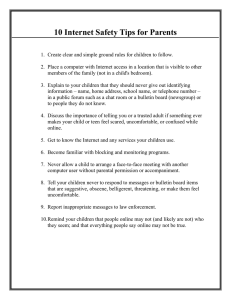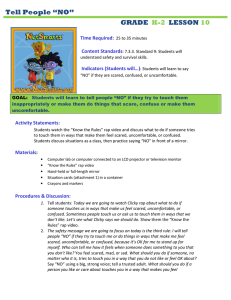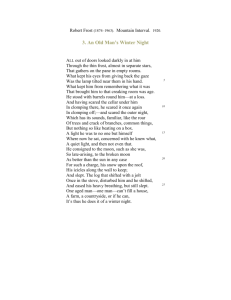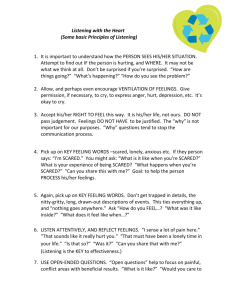Tell People “NO” GRADE LESSON
advertisement
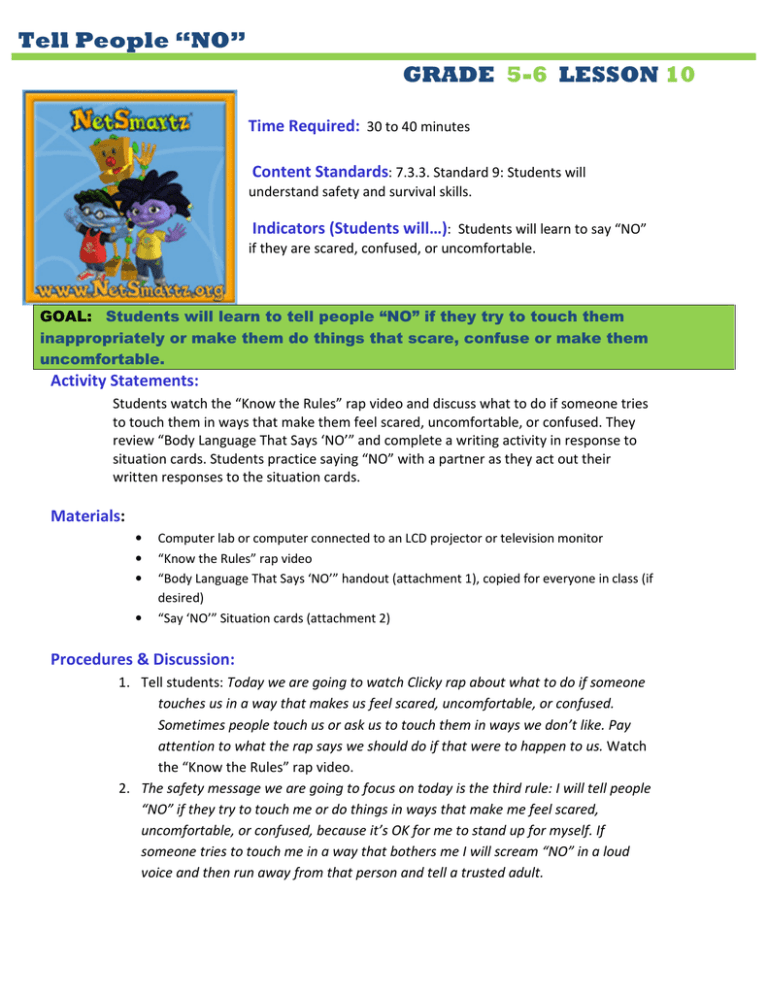
Tell People “NO” GRADE 5-6 LESSON 10 Time Required: 30 to 40 minutes Content Standards: 7.3.3. Standard 9: Students will understand safety and survival skills. Indicators (Students will…): Students will learn to say “NO” if they are scared, confused, or uncomfortable. GOAL: Students will learn to tell people “NO” if they try to touch them inappropriately or make them do things that scare, confuse or make them uncomfortable. Activity Statements: Students watch the “Know the Rules” rap video and discuss what to do if someone tries to touch them in ways that make them feel scared, uncomfortable, or confused. They review “Body Language That Says ‘NO’” and complete a writing activity in response to situation cards. Students practice saying “NO” with a partner as they act out their written responses to the situation cards. Materials: • • • • Computer lab or computer connected to an LCD projector or television monitor “Know the Rules” rap video “Body Language That Says ‘NO’” handout (attachment 1), copied for everyone in class (if desired) “Say ‘NO’” Situation cards (attachment 2) Procedures & Discussion: 1. Tell students: Today we are going to watch Clicky rap about what to do if someone touches us in a way that makes us feel scared, uncomfortable, or confused. Sometimes people touch us or ask us to touch them in ways we don’t like. Pay attention to what the rap says we should do if that were to happen to us. Watch the “Know the Rules” rap video. 2. The safety message we are going to focus on today is the third rule: I will tell people “NO” if they try to touch me or do things in ways that make me feel scared, uncomfortable, or confused, because it’s OK for me to stand up for myself. If someone tries to touch me in a way that bothers me I will scream “NO” in a loud voice and then run away from that person and tell a trusted adult. Tell People “NO” GRADE 5-6 LESSON 10 Who can tell me how it feels when someone does something to you that you don’t like? You feel scared, mad, or sad. • What should you do if someone, no matter who it is, tries to touch you in a way that you do no like or feel OK about? Say “NO” using a big, strong voice; tell a trusted adult. • What should you do if someone you like or care about touches you in a way that makes you feel uncomfortable or confused? It’s not always easy to say “NO” to this person, but you have the right to stand up for yourself; no one has the right to ask you to do anything that makes you feel bad or scared. • Most touch is good and can help us feel better and safer. What are some examples of good touch? A hug from your grandmother, a high-five from a friend, or your parent or guardian kissing you goodnight. • If a person tries to do something to you or your body, or asks you to do something to him or her that makes you feel uncomfortable, you should tell a trusted adult right away. 3. Introduce the activity by asking: What does it mean to be polite? Saying please and thank you not interrupting others when they talk; treating others with respect. When is it appropriate to not be polite to another person? If the person is being unkind or mean, if you are scared or in danger, or if your feelings warn you that something is wrong. • What are some specific examples of situations where you need to keep yourself safer instead of worrying about being polite? When someone touches you in a way that makes you feel scared, uncomfortable, or confused; when someone older approaches you in a harassing or threatening way and a trusted adult is not nearby; when you receive a phone call that makes you feel uncomfortable or scared; when you are offered a ride, food, gifts, or an invitation by people you don’t know or trust; or if someone is hurting you or making you feel uncomfortable. • What are some ways you can respond if you are being bothered or bullied by someone else? Say “NO” using a clear, strong, and loud voice. Say things like “No, I don’t want to” or “I want you to stop.” Remember, someone who is not trying to hurt you will stop when you say “NO.” If this person doesn’t listen and doesn’t stop, run away, and find a trusted adult immediately. If the person keeps holding you or still touches you, it’s OK to scream, yell, wiggle, push away, or even kick or bite if you need to in order to get away. • Tell People “NO” GRADE 5-6 LESSON 10 4. Body language is important in getting your message across to the person who is bothering you. By knowing and using assertive body language, you will be in a better situation to protect yourself. Pass out the “Body Language That Says ‘NO’” handout (attachment 1) and go over the points listed with your class. If desired, have students list other body language. Have the class say each word or phrase as you point to it. While children should be encouraged to speak up, forcefulness -not loudness -- is key. Pass out one situation card (attachment 2) to every student (duplicates OK). Suggested solutions have been provided to help with discussion. Have students write a one paragraph response to these situation cards. If time permits, have them act out their responses to the class. Discuss with students when it is appropriate to use assertive body language and when it is appropriate to firmly, yet respectfully, tell someone “NO.” Encourage students to share these body language moves with their trusted adult. Additional Resources: www.NetSmartz.org Extension Activities
